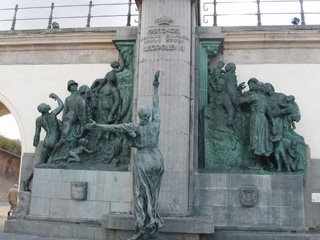We arrived in Ostend, the biggest city our Professor grew up
next to, so he gave us a tour of the town. We visited the local Fishing Port,
the James Ensor House, and saw a Memorial of Leopold II.
 |
| Figure 1: The living room in Ensor House. |
I was most impressed by the Ensor House and the Monument of
Leopold II. Both of these men are very accomplished and the people who admired
their works decided to commemorate their contributions to the town by
dedicating a museum or statue to them. The Ensor House was very artistic, which
makes sense because he was a talented artist. He even said “Je crois etre un
peintre d’exception…” (I think I am an extraordinary painter…) Usually, when
people think of something, those thoughts become their words, and if they
really mean it, their words become their actions, their actions become their
character, and then their character defines who and what they are. Ensor
thought he was a talented painter, thus he produced many paintings that is
today at the top of western art history, here in the ‘Queen of seaside resorts’!
His works were worth preserving and displaying in his house because they
express the culture of Ostend. He spent most of his life there and his
inspirations for some of his works came from the souvenir shop which sold items
such as shells, beads, toys, and masks. His works express a combination of his
personality and life as an inhabitant of Ostend.
 |
| Figure 2: Leopold II monument. The slave to the left has his arm chopped off. All the Belgians and Africans look up to Leopold who is not pictured. |
The Leopold II Monument also impressed me because of its
duel function: it commemorates Leopold II as the Belgian king who established
Ostend as a stylish and fashionable seaside retreat, but it also represents the
price that was paid to achieve all the rubber and ivory from the “Congolese
Free State”, powered by forced labor that lead to the deaths of 3 million
Congolese. The monument shows the King on horseback above the clambering
figures of his subjects, both European (Belgian) and African (Congolese).
Initially, the monument was to commemorate him and thank him for bringing
Ostend the reputation it has now, but after the hand of the slave was cut off,
the monument portrayed a different meaning. Whenever a bullet was shot, a hand
had to be presented to Leopold as payment for the bullet and as proof that work
was being done at the Congo. The missing hand makes the monument’s meaning a
little more controversial, especially since the monument was meant to
commemorate the King’s good deed for the city. In any case, the monument now
shows the full story of what resulted from the “Congolese Free State”: 3
million Congolese were forced to extract rubber and ivory which were used to
help the European economy to produce a pleasant town such as Ostend.
they say Leopold II and his exploitation cost some 10 million lives. The man was a monster!
ReplyDelete